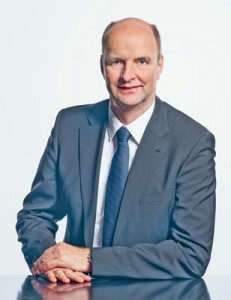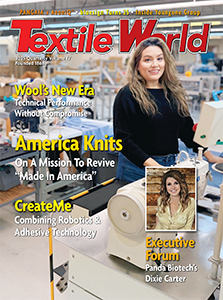Georg Stausberg, CEO, Oerlikon Manmade Fibers, discusses developments in the industrial nonwovens sector.
TW Special Report
Germany-based Oerlikon Neumag will present its comprehensive product portfolio for manufacturing nonwovens from polyester (PET), polypropylene (PP) and other raw materials to an international audience at the upcoming IDEA show to be held in Boston, May 3-5, 2016. The company’s competencies lie in the development and implementation of engineering solutions for the production of industrial nonwovens. Textile World spoke with Georg Stausberg, CEO, Oerlikon Manmade Fibers segment, about the latest developments in this sector.
Textile World: Oerlikon Neumag focuses its spunbond technology on industrial applications. What market potential do you see for this application in the future?
 Georg Stausberg: Today, almost 50 percent of all nonwovens already are produced directly from polymer chips, and this share is growing. Although the majority is used in hygiene, medical and wipe products, spunbond and meltblown products are on the rise in industrial applications, increasingly replacing classical materials such as wovens and films, but also carded nonwovens, as a result of their technical and commercial benefits. In building construction, for example, the share of spunbond products is already over 80 percent and more than 50 percent in the case of filter nonwovens, while geotextile applications are also growing in significance.
Georg Stausberg: Today, almost 50 percent of all nonwovens already are produced directly from polymer chips, and this share is growing. Although the majority is used in hygiene, medical and wipe products, spunbond and meltblown products are on the rise in industrial applications, increasingly replacing classical materials such as wovens and films, but also carded nonwovens, as a result of their technical and commercial benefits. In building construction, for example, the share of spunbond products is already over 80 percent and more than 50 percent in the case of filter nonwovens, while geotextile applications are also growing in significance.
TW: PET is increasingly popular as a raw material for industrial spunbonds. What benefits does PET offer over other polymers?
Stausberg: Raw material and manufacturing costs, and the actual material properties play important roles in manufacturing nonwovens. Here, PET has clear advantages. On one hand, the global market price of PP, frequently used as the raw material to date, has been consistently higher than that of PET. On the other hand, sustainability, heat protection, energy consumption and insulation are hugely important to users in the construction industry, for instance. PET nonwovens often satisfy the corresponding requirements with the minimal use of materials and without additives. They protect against cooling, absorb only minimum moisture, can be easily used as insulating materials, are recyclable, and hence, are an alternative to plastic foams, glass wool or mineral wool.
TW: You mentioned minimal use of materials and no additives. What does that mean?
Stausberg: The strength of the nonwoven is frequently hugely important in industrial applications. They need to be extremely tear-resistant and simultaneously very extensible. These properties must be achieved with the lowest possible weight and optimized raw material usage, because the raw material costs make up around 75 to 85 percent of the manufacturing costs in the case of spunbonds. Here, benchmark comparisons with conventional products in Europe have shown that considerably higher nonwoven strengths can be achieved with comparable weights using Oerlikon Neumag’s innovative spunbond technology.
TW: Can you name concrete figures with regards to the savings?
Stausberg: Yes, we can, thanks to the process-optimized solutions of our engineers. Raw material savings of more than 5 percent are possible.
TW: What other benefits can be achieved by deploying Oerlikon Neumag technology?
Stausberg: In addition to the quality of the end product, low operating costs play an important role in the decision to invest in modern spunbond systems. We have comprehensive developments in our portfolio aimed at keeping these operating costs as low as possible. Our focus has been on reducing energy consumption, the second largest operating cost. In this way, our new generation of spunbond systems saves almost 20 percent in terms of energy requirements. This optimization can make a difference of around 30 percent compared to conventional PET spunbond processes.
TW: Thirty-percent lower energy requirements results in significant savings, does it not?
Stausberg: That’s right. Together with raw materials savings and further optimizations in our technology, the conversion costs are up to 30-percent below those of conventional spunbond systems.
TW: How has Oerlikon achieved these savings?
Stausberg: By focusing on industrial applications for our spunbond technology, we have built up comprehensive know-how covering the overall process, including the necessary in-line further processing. In collaboration with well-known companies, we have been able to considerably expand our further processing knowledge and draw conclusions for the spinning process and hence the overall process. Within this context, we have once again considerably expanded our applications research and development center in Neumünster, Germany, over the past three years.
TW: As part of the Oerlikon Manmade Fiber segment, Oerlikon Neumag is a company offering a broad range of technologies for the most diverse applications. Do these technologies profit from each other?
Stausberg: The three Oerlikon Neumag technology divisions — BCF, staple fiber and nonwovens — benefit heavily from each other. Add to this the experience from PET, PP and polyamide filament spinning systems at Oerlikon Barmag. With this knowledge and expertise, we have adapted our extensive know-how in manufacturing bicomponent staple fibers to the spunbond process, which has considerably simplified optimizing the bicomponent nonwovens process. To this end, we can today also offer our customers requirements-oriented production solutions for these applications. Furthermore, the process know-how acquired from spinning high-tenacity fibers while improving the spunbond spinning system has enabled us to offer solutions for demanding products.
TW: In addition to spunbond technology, Oerlikon also offers other nonwoven technologies. What is the situation with these products?
Stausberg: We are needless to say constantly further developing our meltblown and airlaid technologies as well. Current installations at leading manufacturers show that Oerlikon is a coveted partner when it comes to these technologies. We are very much looking forward to showing our customers our latest product developments at IDEA.
March/April 2016




